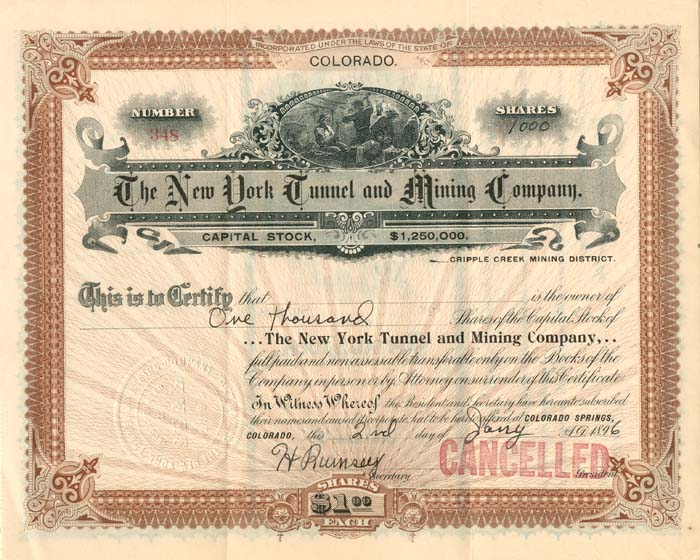New York Tunnel and Mining Co. - Stock Certificate
Inv# MS2141 Stock
Stock. Cripple Creek, Colorado.
"Part-time cowboy and full-time drinker" Robert Womack found gold float in 1879, which led him to digging countless prospecting holes in an attempt to find its lode, earning him the name "Crazy Bob". His efforts finally paid off in 1890, when he found the El Paso lode. Winfield Scott Stratton discovered what became his Portland Mine at the site of Victor. By 1893, 10,000 miners working the district produced one third of Colorado's gold output. Gold cyanidation was introduced in 1895, and used alongside chlorination in the mills for gold extraction. By 1895, half of Colorado's gold production of 660,000 ounces came from the district. In 1897, half a million Troy ounces of gold was produced, and in 1900, 900,000 troy ounces, two thirds of the US output. By 1920, 41 mines were active, and cumulative gold production was over 500 tons.
Located a few miles southwest of Pike's Peak, the Cripple Creek district wasn't discovered until later in the "rush", which was known as the "Pike's Peak Gold Rush", because Pike's Peak was a landmark visible 100 mi (160 km) out on the plains. The towns of Cripple Creek and Victor were established to serve the mines and miners of the district. Among the principal mines were the Mollie Kathleen Gold Mine at Cripple Creek and Stratton's Independence mine, at Victor, Colorado. Gold production up to 1990 was 21,000,000 troy ounces (650 t) worth about US$17 billion at 2008 prices), making it the most productive gold-producing district in Colorado, and the third-most productive in the United States (after Carlin, Nevada and Lead, South Dakota). Many of the mines in the district were quite deep and difficult to drain. The almost five-mile (8.0 km) Roosevelt Tunnel was a mine drainage tunnel dug between 1907 and 1919 below the Cripple Creek area to drain the mines and simplify ore haulage.
The Cripple Creek mining district covers a Miocene volcanic caldera filled with quartz latite porphyry. The ore bodies are veins and replacement zones within the quartz latite. The ore minerals are gold and silver tellurides, with accessory fluorite.
Some miners who worked in this district died in different ways including flu, pneumonia, in the mine, at home, or suicide. A list of dead miners has been recorded in a small notebook labeled "Dead". A photocopy of the notebook is held by the Cripple Creek District Museum.
A stock certificate is issued by businesses, usually companies. A stock is part of the permanent finance of a business. Normally, they are never repaid, and the investor can recover his/her money only by selling to another investor. Most stocks, or also called shares, earn dividends, at the business's discretion, depending on how well it has traded. A stockholder or shareholder is a part-owner of the business that issued the stock certificates.










Ebay ID: labarre_galleries